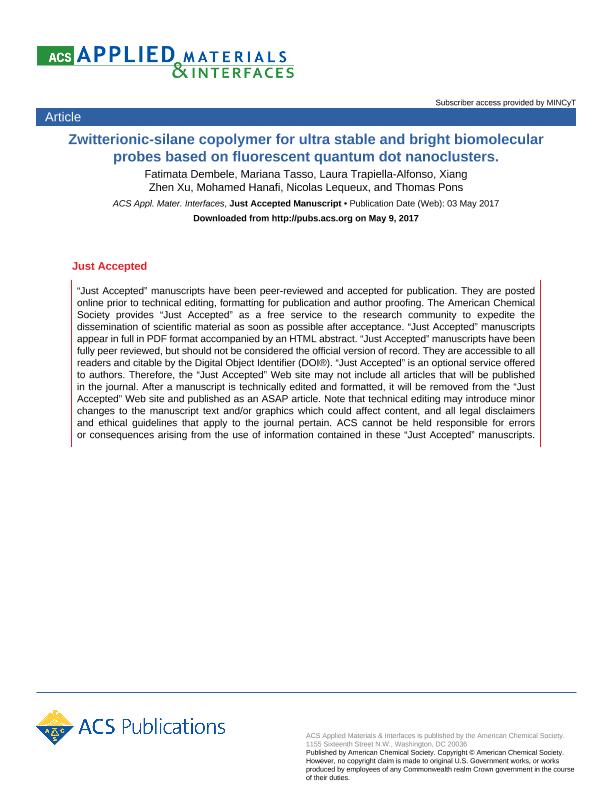Artículo
Zwitterionic Silane Copolymer for Ultra-Stable and Bright Biomolecular Probes Based on Fluorescent Quantum Dot Nanoclusters
Dembele, Fatimata; Tasso, Mariana Patricia ; Trapiella Alfonso, Laura; Xu, Xiangzhen; Hanafi, Mohamed; Lequeux, Nicolas; Pons, Thomas
; Trapiella Alfonso, Laura; Xu, Xiangzhen; Hanafi, Mohamed; Lequeux, Nicolas; Pons, Thomas
 ; Trapiella Alfonso, Laura; Xu, Xiangzhen; Hanafi, Mohamed; Lequeux, Nicolas; Pons, Thomas
; Trapiella Alfonso, Laura; Xu, Xiangzhen; Hanafi, Mohamed; Lequeux, Nicolas; Pons, Thomas
Fecha de publicación:
05/2017
Editorial:
American Chemical Society
Revista:
ACS Applied Materials & Interfaces
ISSN:
1944-8244
Idioma:
Inglés
Tipo de recurso:
Artículo publicado
Clasificación temática:
Resumen
Fluorescent semiconductor quantum dots (QDs) exhibit several unique properties that make them suitable candidates for biomolecular sensing, including high brightness, photostability, broad excitation, and narrow emission spectra. Assembling these QDs into robust and functionalizable nanosized clusters (QD-NSCs) can provide fluorescent probes that are several orders of magnitude brighter than individual QDs, thus allowing an even greater sensitivity of detection with simplified instrumentation. However, the formation of compact, antifouling, functionalizable, and stable QD-NSCs remains a challenging task, especially for a use at ultralow concentrations for single-molecule detection. Here, we describe the development of fluorescent QD-NSCs envisioned as a tool for fast and sensitive biomolecular recognition. First, QDs were assembled into very compact 100-150 nm diameter spherical aggregates; the final QD-NSCs were obtained by growing a cross-linked silica shell around these aggregates. Hydrolytic stability in several concentration and pH conditions is a key requirement for a potential and efficient single-molecule detection tool. However, the hydrolysis of Si-O-Si bonds leads to desorption of monosilane-based surface groups at very low silica concentrations or in a slightly basic medium. Thus, we designed a novel multidentate copolymer composed of multiple silane as well as zwitterionic monomers. Coating silica beads with this multidentate copolymer provided a robust surface chemistry that was demonstrated to be stable against hydrolysis, even at low concentrations. Copolymer-coated silica beads also showed low fouling properties and high colloidal stability in saline solutions. Furthermore, incorporation of additional azido-monomers enabled easy functionalization of QD-NSCs using copper-free bio-orthogonal cyclooctyne-azide click chemistry, as demonstrated by a biotin-streptavidin affinity test.
Palabras clave:
Biodetection
,
Nanoclusters
,
Quantum Dots
,
Silica
,
Zwitterionic Copolymers
Archivos asociados
Licencia
Identificadores
Colecciones
Articulos(INIFTA)
Articulos de INST.DE INV.FISICOQUIMICAS TEORICAS Y APLIC.
Articulos de INST.DE INV.FISICOQUIMICAS TEORICAS Y APLIC.
Citación
Dembele, Fatimata; Tasso, Mariana Patricia; Trapiella Alfonso, Laura; Xu, Xiangzhen; Hanafi, Mohamed; et al.; Zwitterionic Silane Copolymer for Ultra-Stable and Bright Biomolecular Probes Based on Fluorescent Quantum Dot Nanoclusters; American Chemical Society; ACS Applied Materials & Interfaces; 9; 21; 5-2017; 18161-18169
Compartir
Altmétricas



